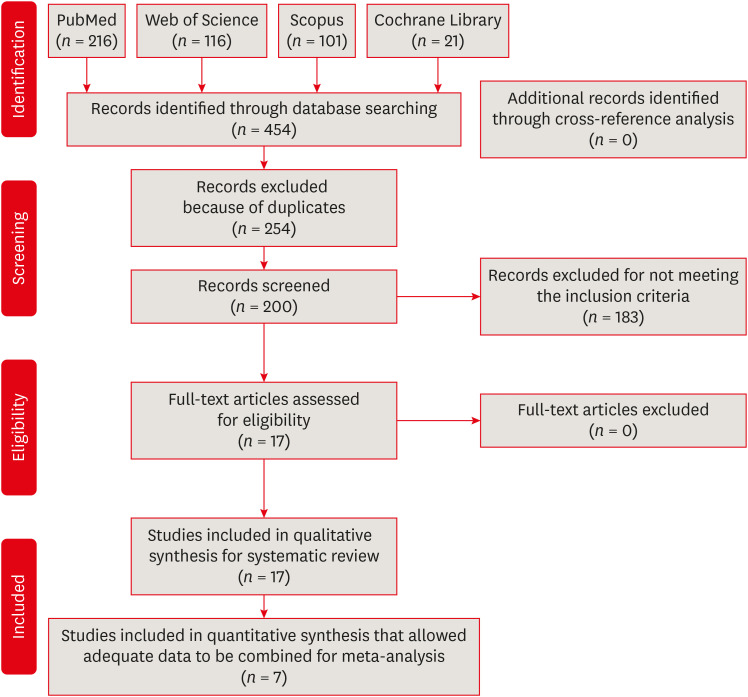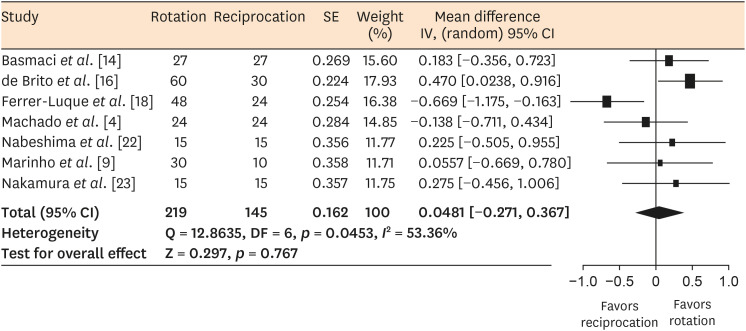Restor Dent Endod.
2021 May;46(2):e19. 10.5395/rde.2021.46.e19.
Influence of reciprocating and rotary instrumentation on microbial reduction: a systematic review and meta-analysis of in vitro studies
- Affiliations
-
- 1Department of Endodontics, Faculty of Dentistry, Hacettepe University, Ankara, Turkey
- 2Department of Biostatistics, Faculty of Medicine, Hacettepe University, Ankara, Turkey
- KMID: 2548063
- DOI: http://doi.org/10.5395/rde.2021.46.e19
Abstract
Objectives
The purpose of this study was to conduct a systematic review and meta-analysis of in vitro studies regarding the effectiveness of reciprocating and rotary instrumentation on microbial reduction in root canals.
Materials and Methods
PubMed, Scopus, Web of Science, the Cochrane Library, and the gray literature were searched through December 2019. Studies comparing the influence of reciprocating and rotary instrumentation on the removal of microorganisms from root canals that quantified the antimicrobial effect were included. Data extraction was completed using a systematic form for data collection. The risk of bias of the studies was evaluated. Standardized mean differences (SMDs) and confidence intervals (CIs) were calculated using a random effects meta-analysis.
Results
Seventeen in vitro studies were included in this systematic review, of which 7 provided adequate data for inclusion in the meta-analysis. Both reciprocating and rotary systems were similarly effective in reducing the microbial load in infected root canals (SMD [95% CI], 0.0481 [−0.271, 0.367]). Three studies showed a low risk of bias, whereas most of the studies (82%) presented a medium risk.
Conclusions
Although both techniques decrease the microbial content (with reductions of 23.32%–88.47% and 23.33%–89.86% for reciprocating and rotary instrumentation, respectively), they are not able to provide complete disinfection of root canals.
Keyword
Figure
Cited by 1 articles
-
Does minimally invasive canal preparation provide higher fracture resistance of endodontically treated teeth? A systematic review of
in vitro studies
Sıla Nur Usta, Emmanuel João Nogueira Leal Silva, Seda Falakaloğlu, Mustafa Gündoğar
Restor Dent Endod. 2023;48(4):e34. doi: 10.5395/rde.2023.48.e34.
Reference
-
1. Siqueira JF Jr, Rôças IN. Clinical implications and microbiology of bacterial persistence after treatment procedures. J Endod. 2008; 34:1291–1301.e3. PMID: 18928835.
Article2. Siqueira JF Jr, Rôças IN, Santos SR, Lima KC, Magalhães FA, de Uzeda M. Efficacy of instrumentation techniques and irrigation regimens in reducing the bacterial population within root canals. J Endod. 2002; 28:181–184. PMID: 12017176.
Article3. Alves FR, Rôças IN, Almeida BM, Neves MA, Zoffoli J, Siqueira JF Jr. Quantitative molecular and culture analyses of bacterial elimination in oval-shaped root canals by a single-file instrumentation technique. Int Endod J. 2012; 45:871–877. PMID: 22452547.
Article4. Machado ME, Nabeshima CK, Leonardo MF, Reis FA, Britto ML, Cai S. Influence of reciprocating single-file and rotary instrumentation on bacterial reduction on infected root canals. Int Endod J. 2013; 46:1083–1087. PMID: 23566213.
Article5. Short JA, Morgan LA, Baumgartner JC. A comparison of canal centering ability of four instrumentation techniques. J Endod. 1997; 23:503–507. PMID: 9587320.
Article6. De-Deus G, Brandão MC, Barino B, Di Giorgi K, Fidel RA, Luna AS. Assessment of apically extruded debris produced by the single-file ProTaper F2 technique under reciprocating movement. Oral Surg Oral Med Oral Pathol Oral Radiol Endod. 2010; 110:390–394. PMID: 20727500.
Article7. Martinho FC, Chiesa WM, Marinho AC, Zaia AA, Ferraz CC, Almeida JF, Souza-Filho FJ, Gomes BP. Clinical investigation of the efficacy of chemomechanical preparation with rotary nickel-titanium files for removal of endotoxin from primarily infected root canals. J Endod. 2010; 36:1766–1769. PMID: 20951284.
Article8. Siqueira JF Jr, Alves FR, Versiani MA, Rôças IN, Almeida BM, Neves MA, Sousa-Neto MD. Correlative bacteriologic and micro-computed tomographic analysis of mandibular molar mesial canals prepared by self-adjusting file, reciproc, and twisted file systems. J Endod. 2013; 39:1044–1050. PMID: 23880274.
Article9. Marinho AC, Martinho FC, Gonçalves LM, Rabang HR, Gomes BP. Does the Reciproc file remove root canal bacteria and endotoxins as effectively as multifile rotary systems? Int Endod J. 2015; 48:542–548. PMID: 25070009.
Article10. De-Deus G, Moreira EJ, Lopes HP, Elias CN. Extended cyclic fatigue life of F2 ProTaper instruments used in reciprocating movement. Int Endod J. 2010; 43:1063–1068. PMID: 21080616.
Article11. Siddique R, Nivedhitha MS. Effectiveness of rotary and reciprocating systems on microbial reduction: a systematic review. J Conserv Dent. 2019; 22:114–122. PMID: 31142978.
Article12. Moher D, Liberati A, Tetzlaff J, Altman DG; PRISMA Group. Preferred reporting items for systematic reviews and meta-analyses: the PRISMA statement. J Clin Epidemiol. 2009; 62:1006–1012. PMID: 19631508.
Article13. Alves FR, Paiva PL, Marceliano-Alves MF, Cabreira LJ, Lima KC, Siqueira JF Jr, Rôças IN, Provenzano JC. Bacteria and hard tissue debris extrusion and intracanal bacterial reduction promoted by XP-endo shaper and reciproc instruments. J Endod. 2018; 44:1173–1178. PMID: 29861066.
Article14. Basmaci F, Oztan MD, Kiyan M. Ex vivo evaluation of various instrumentation techniques and irrigants in reducing E. faecalis within root canals. Int Endod J. 2013; 46:823–830. PMID: 23441862.
Article15. Dagna A, Arciola CR, Visai L, Selan L, Colombo M, Bianchi S, Poggio C. Antibacterial efficacy of conventional and single-use Ni-Ti endodontic instruments: an in vitro microbiological evaluation. Int J Artif Organs. 2012; 35:826–831. PMID: 23080217.
Article16. de Brito PRR, Lima PM, Leal Silva EJN, Rivera Fidel S, Fidel RAS, Sassone LM. Effectiveness of ProTaper Next, ProTaper Universal and WaveOne systems in reducing intracanal bacterial load. Endod Pract Today. 2016; 10:167–173.17. DE Oliveira BP, Aguiar CM, Câmara AC, DE Albuquerque MM, Correia AC, Soares MF. Evaluation of microbial reduction in root canals instrumented with reciprocating and rotary systems. Acta Stomatol Croat. 2015; 49:294–303. PMID: 27688413.
Article18. Ferrer-Luque CM, Bejarano I, Ruiz-Linares M, Baca P. Reduction in Enteroccocus faecalis counts - a comparison between rotary and reciprocating systems. Int Endod J. 2014; 47:380–386. PMID: 23980811.19. Guillén RE, Nabeshima CK, Caballero-Flores H, Cayón MR, Mercadé M, Cai S, Machado MEL. Evaluation of the WaveOne Gold and One Shape New Generation in reducing Enterococcus faecalis from root canal. Braz Dent J. 2018; 29:249–253. PMID: 29972450.
Article20. Karataş E, Gültekin E, Arslan H, Kirici DÖ, Alsancak M, Topçu MÇ. Evaluation of instrumentation systems in reducing E. faecalis from root canals: TF adaptive and ProTaper next versus single file systems. Int J Artif Organs. 2015; 38:161–164. PMID: 25867700.
Article21. Krokidis A, Bonfanti C, Cerutti AC, Barabanti N, Panopoulos P. Rotary versus reciprocating shaping files in bacterial elimination from long oval canals. Aust Endod J. 2018; 44:240–244. PMID: 29034579.
Article22. Nabeshima CK, Caballero-Flores H, Cai S, Aranguren J, Borges Britto ML, Machado ME. Bacterial removal promoted by 2 single-file systems: Wave One and One Shape. J Endod. 2014; 40:1995–1998. PMID: 25149120.
Article23. Nakamura VC, Candeiro GT, Cai S, Gavini G. Ex vivo evaluation of three instrumentation techniques on E. faecalis biofilm within oval shaped root canals. Braz Oral Res. 2015; 29:29.24. Üreyen Kaya B, Erik CE, Sesli Çetin E, Köle M, Maden M. Mechanical reduction in intracanal Enterococcus faecalis when using three different single-file systems: an ex vivo comparative study. Int Endod J. 2019; 52:77–85. PMID: 29985531.
Article25. Vasconcelos LR, Midena RZ, Minotti PG, Pereira TC, Duarte MA, Andrade FB. Effect of ultrasound streaming on the disinfection of flattened root canals prepared by rotary and reciprocating systems. J Appl Oral Sci. 2017; 25:477–482. PMID: 29069144.
Article26. Higgins JP, Thompson SG, Deeks JJ, Altman DG. Measuring inconsistency in meta-analyses. BMJ. 2003; 327:557–560. PMID: 12958120.
Article27. Sjögren U, Figdor D, Persson S, Sundqvist G. Influence of infection at the time of root filling on the outcome of endodontic treatment of teeth with apical periodontitis. Int Endod J. 1997; 30:297–306. PMID: 9477818.
Article28. Molander A, Warfvinge J, Reit C, Kvist T. Clinical and radiographic evaluation of one- and two-visit endodontic treatment of asymptomatic necrotic teeth with apical periodontitis: a randomized clinical trial. J Endod. 2007; 33:1145–1148. PMID: 17889679.
Article29. Bürklein S, Hinschitza K, Dammaschke T, Schäfer E. Shaping ability and cleaning effectiveness of two single-file systems in severely curved root canals of extracted teeth: Reciproc and WaveOne versus Mtwo and ProTaper. Int Endod J. 2012; 45:449–461. PMID: 22188401.
Article30. Alves FR, Siqueira JF Jr, Carmo FL, Santos AL, Peixoto RS, Rôças IN, Rosado AS. Bacterial community profiling of cryogenically ground samples from the apical and coronal root segments of teeth with apical periodontitis. J Endod. 2009; 35:486–492. PMID: 19345792.
Article31. Portenier I, Waltimo T, Ørstavik D, Haapasalo M. The susceptibility of starved, stationary phase, and growing cells of Enterococcus faecalis to endodontic medicaments. J Endod. 2005; 31:380–386. PMID: 15851934.
Article32. Siqueira JF Jr, Rôças IN. Diversity of endodontic microbiota revisited. J Dent Res. 2009; 88:969–981. PMID: 19828883.
Article33. Rôças IN, Siqueira JF Jr. Identification of bacteria enduring endodontic treatment procedures by a combined reverse transcriptase-polymerase chain reaction and reverse-capture checkerboard approach. J Endod. 2010; 36:45–52. PMID: 20003934.
Article34. Nair PN. Pathogenesis of apical periodontitis and the causes of endodontic failures. Crit Rev Oral Biol Med. 2004; 15:348–381. PMID: 15574679.35. Higgins JPT, Green S. Cochrane Handbook for Systematic Reviews of Interventions. Version 5.1.0. London: The Cochrane Collaboration;2011.36. Uzunoglu-Özyürek E, Küçükkaya Eren S, Karahan S. Effect of root canal sealers on the fracture resistance of endodontically treated teeth: a systematic review of in vitro studies. Clin Oral Investig. 2018; 22:2475–2485.
Article
- Full Text Links
- Actions
-
Cited
- CITED
-
- Close
- Share
- Similar articles
-
- Effectiveness and safety of rotary and reciprocating kinematics for retreatment of curved root canals: a systematic review of in vitro studies
- The effectiveness of the supplementary use of the XP-endo Finisher on bacteria content reduction: a systematic review and meta-analysis
- An Introduction of the Systematic Review and Meta-Analysis
- Critical Appraisal of Systematic Review/Meta-analysis
- The effect of preheating resin composites on surface hardness: a systematic review and meta-analysis



